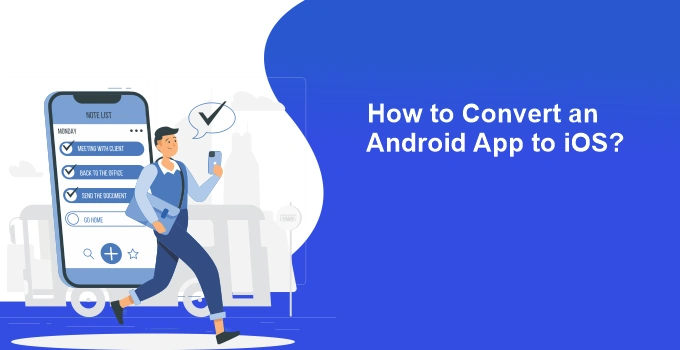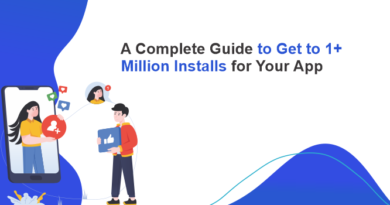How to Convert an Android App to iOS? in 4 Easy Steps
- Significance of Transformation of Android App to iOS
- A Complete Process to Transfer Android App to iOS
- Step 1: Assessment of App Specification and Functionality
- Step 2: Modify Draft for App Porting
- Step 3: Tailor Coding and Construction Element
- Step 4: Official App Trial and Launch
- Key Distinction when Converting Android App To iOS
- Programming Language
- iOS Platform Is Best to Innovate Your App
If you’re an entrepreneur considering entering the mobile app development industry, it may make sense to start with one platform, like iOS. Developing a mobile app costs a lot of time and money, so it’s important to fully explore the benefits of your new app. With the help of the test, you can validate your idea in a specific market and determine how to gain the highest return on investment in it.
In case you want to understand how to convert Android apps into iOS apps, or in case you want to know how to convert iOS apps into Android apps, the blog has all the answers you are searching for.
Significance of Transformation of Android App to iOS
Android and iOS are the top smartphone software platforms of today. iOS has a large market share compared to Android devices. Converting from one platform to another is a necessary step for android app developers to enlarge their user base, improve operating profits and increase brand visibility. Android apps developers prefer converting android applications into iOS because it saves time and costs. A mobile app developer can easily complete the porting process within 1-2 months using an experienced iOS app development company like hire mobile development experts.
It has possible advantages:
- You can increase your market share by creating a complex application that many users will want to use.
- Although the apps for Android and iOS are built on the same code, there’s a lot more to migrating an Android app than just copying it.
- You can boost ROI by using a new app monetization model.
- Since the developer has to go through fewer steps before starting the implementation process, they’ll be able to do it faster.
Click here to read: How to Monetize an App? Best App Monetization Strategies
A Complete Process to Transfer Android App to iOS
Transferring an Android app to iOS involves a few key steps. First, assess and adjust the app’s design to meet iOS guidelines. Next, rewrite the app using iOS-compatible programming languages like Swift. Finally, test the app on iOS devices to ensure functionality and user experience are intact. Let’s know about each of the step in detail.
Step 1: Assessment of App Specification and Functionality
First, the Software company and their client work together to collect and analyze all existing training materials. For instance, they would analyze the existing app’s original design, functional specification, and source code. If your app has business logic, then you will need to change some technical components .you should consider elements of the marketing campaign that might be influenced by changes in content, such as push notifications and the use of 3D Touch on iOS.
When converting from Android to iOS, you need to distinguish the business-related aspects and those that are technical. Therefore, the most efficient way to identify technical risks is to have a business stakeholder help with them and at the same time assign two specialists to perform a gap analysis. They will examine the existing app’s complexity, functionality, and performance, and propose steps to improve any gaps.
Important points:
- Make sure to check for any inefficiency in your app, as well as potential improvement possibilities.
- It’s important to analyze each aspect of the business logic and see how it translates to related factors in your new project.
- Check whether any third-party frameworks are included and have been correctly integrated with the application.
The initial step in converting an app to a business will result in the following deliverables:
- Marketplace Analysis
- Plan Mind-Map
- Functional Requirement
- Code Examination
- Design Assessment
Click here to read: 15 Key Features for a Successful Mobile Commerce App
Step 2: Modify Draft for App Porting
The other way would be to modify the user interface and layout, but since the app has to be coded from scratch, that’s not feasible. Don’t just copy the existing UI. Continue to adjust it until you make the app look, feel, and/or navigate in a way that works for your users.
1.Data vs Flat Draft Design
Apple’s iOS operating system has different design patterns compared to Google’s Android operating system, and different design patterns mean that creating a mobile app for both platforms will require different steps. The biggest difference is the placement of objects. The material design seems more three-dimensional
2.UI Draft
User Interface Design is not Graphic Design, although UI designers use graphic elements to display the information users need. Therefore it is important to understand what users need from a website and how they use the interface to create the right design.
3. Writing Style to Put on When Changing an App
Confined styles used are:
- For the iOS platform, San Francisco is used
- For the Android platform, Roboto is used
When converting apps from one platform to another, you’ll have the opportunity to use custom fonts. Some great examples are the LL Circular font used in AirBnB’s mobile apps. This font makes the apps consistent across platforms.
4. User Interface Imitating
There are many crucial differences between languages that are written from left to right (LTR) and those that are written from right to left (RTL You must take certain differences into account when you convert an Android app to iOS. Because of the way iOS handles RTL languages, you should plan to support RTL languages from the very beginning. Android provides built-in support for RTL (right-to-left) interfaces starting with version 4.2 Jelly Bean, so if you’re designing a UI that relies on native controls, many things will work as expected by default. For Apple’s iOS operating system.
5. Draft Segment Ahead Converting an iOS or Android
Designing a mobile app is a complex process in which the developers first figure out the features of the app and then break them down into individual steps. This helps the development team to implement the app design on a larger scale .when you convert an Android app to iOS, designers will use a 1x size PDF to maintain graphic quality. It is the most basic size and can be easily changed to 2x or 3x by developers if needed.
Step 3: Tailor Coding and Construction Element
The process of turning an Android app into an iOS app is difficult and time-consuming. It requires a lot of work to adapt the Android code to iOS’s programming language, and it also requires extensive time to adjust third-party integrations If your app is converted from an iOS or Android platform, you have to make sure that the new components are compatible. If not, you should either use alternative tools that have more functionality, or you should replace some of your other tools with ones that have more functionality. Regardless of whether you’re converting iOS apps to Android apps or vice versa, both platforms can integrate with the same third-party services.
- Payment Structure: Pay Pal, Braintree
- Systematics: Mixpanel, Google Analytics, crashlytics
- Societal Web: Twitter, Instagram, Facebook, LinkedIn
- Communication System: Easy Post
Android and iOS have little in common. Rewriting an app from one system to the other is a much greater undertaking than you might think If you’re serious about this and you should be here are a few things to keep in mind.
- When you’re planning a multi-language app, you need to verify if all languages are available in your desired app development flow.
- Make sure the app is designed to include the functionality that allows it to be localized.
- When you want to make stop-motion animation, check whether your software will handle that for you.
- For the conversion of an Android app to iOS, you need to check whether all the functionalities can be reproduced or if they need to be adjusted.
- Try creating a Google or Apple account before you are stuck without one.
Step 4: Official App Trial and Launch
Well-tested software can be released with confidence. If you don’t want to lose your clients, you need to make sure that the app is perfect on every platform. About 30% of our time on a project like this will be consumed by the service. Engineers are conducting tests to ensure that the application is completely functional and consistent with the design interface and navigation.
Here’s the list of the actual mechanical tests we ran:
- Practical testing
- Presentation and Load testing
- Authentication testing
To get your app accepted into the app marketplace, you need to make sure it works on a variety of common devices. And by common, we mean: devices that are not rooted with a custom operating system installed and devices that have no modifications to the hardware.
Key Distinction when Converting Android App To iOS
It’s not easy to switch from Android to iOS or vice versa, but if you are dedicated enough and want to get the best results out of your efforts, it’s worth the effort.
When you develop for Android and iOS side by side, some of the challenges might include:
1.Contrast of OS Sort
There are two dominant operating systems used in mobile phones: Android and iOS. Since they both have different design guidelines, it’s difficult to convert a product from one OS to the other. The challenge in going from iOS to Android app development is that there is a greater disparity in OS versions. Some Android users are on the new OS version and others are not. Thus, developers need to ensure their apps are adaptable as far as possible.
Converting an Android app to iOS is much easier when you look at the overall platform usage rates, as well as the rates of specific device users upgrading to the latest operating system.
2.Gadget Segmentation
When one converts Android to iPhone, one should consider the screen size and resolutions. It is not hard when you are converting iPhone to an Android. But with the ease of converting Android to iOS, it is different. If you are only concerned about the iOS platform when building your app, then you need not worry about device fragmentation.
3.Gadget IX/UX
If you are making an app for both Android and iOS, it’s important to consider the different ways of interact with these operating systems.
For UI/UX design, it’s important to keep an eye on the following:
1: Navigation
The requirement of the Android operating system differs from those of the iOS operating system. This is because there are three navigation buttons in Android: Home, Back, and Overview. The buttons on the form trigger certain actions, and therefore will affect user interaction. Thus, the user interface and experience are different between iPhones and Android phones, so you should design the interface differently for iPhone users.
2: Icons
The way your icon looks on a mobile device depends heavily on the operating system you’re using. For example, Android icons tend to be thicker than iOS icons. When converting your app from Android to iOS, you need to follow iOS icon design guidelines.
3: Fonts Types
Android OS uses San Francisco and iOS devices such as iPhones and iPads use Roboto. iOS guidelines for fonts are more restrictive than Android ones, And, both platforms have differences in terms of specific typography requirements.
Programming Language
Although both operating systems work in conjunction with one another, they are also different entities. Meaning, each platform is built upon its language. There are several programming languages that you can use for mobile app development, but most native apps are built using Objective C, Swift, Java, or Kotlin for iOS and Android. Android and iOS apps need to be done in pairs to be converted from one platform to another.
iOS Platform Is Best to Innovate Your App
When it comes to finding a way to get your software developed, there is plenty of good choices out there for you to select from. In the end, the best option is to hire a software development company that knows what they are doing. Converting an app requires extensive development knowledge because the app needs to function as similarly as possible on different operating systems.



